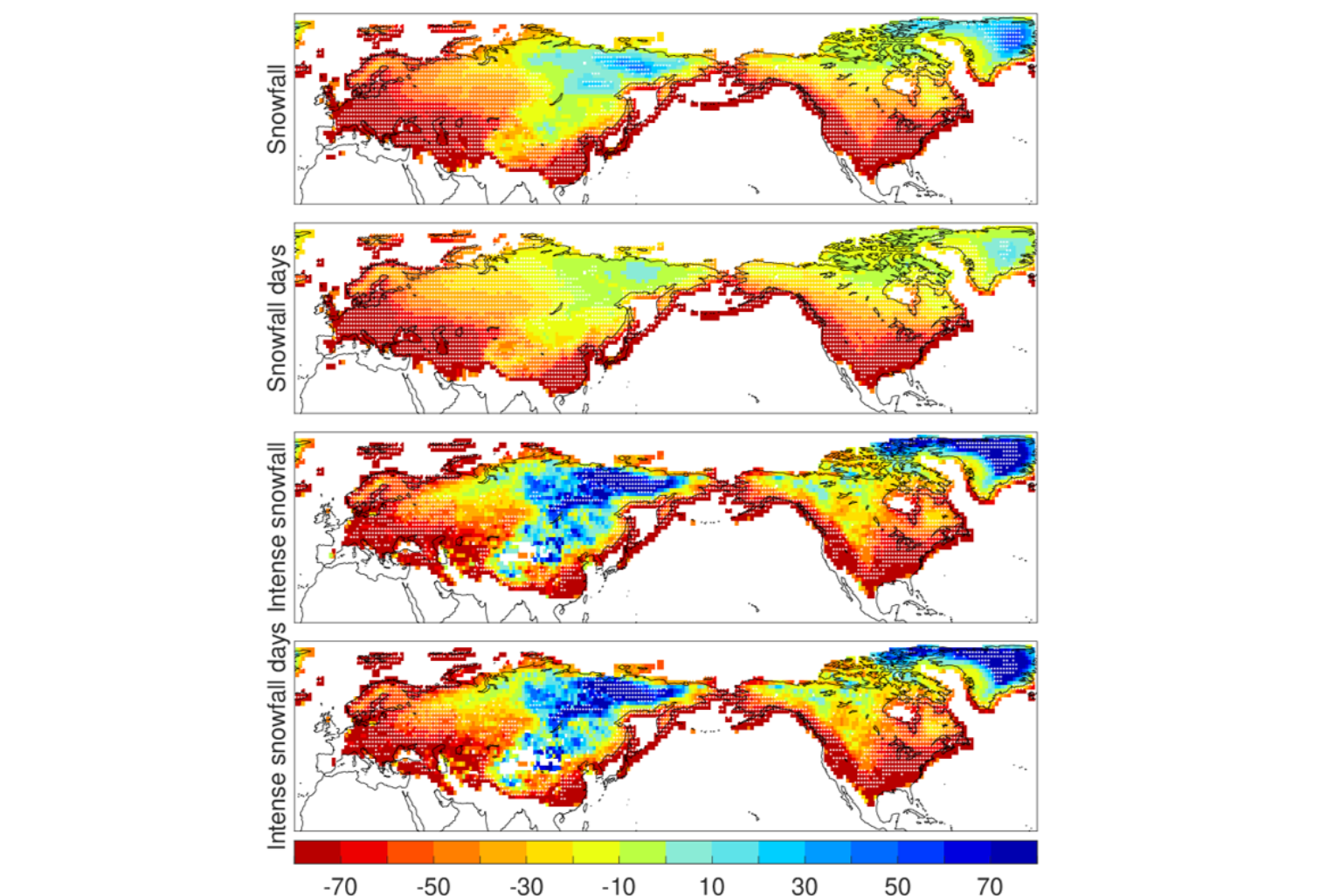联系我们
竺可桢-南森国际研究中心
邮 箱:nzc_iap@mail.iap.ac.cn
邮 编:100029
地 址:北京市朝阳区德胜门外祁家豁子华严里40号 竺南中心

科研进展
Research Progress人类活动将使北半球部分地区未来发生强降雪的概率增加
Anthropogenic influence would increase intense snowfall events over parts of the Northern Hemisphere in the future
[2020-11-12]
【中文介绍】
历史记录表明,全球温度在显著增加,高温热浪频发,气候趋于极端化发展。但在此背景下,尤其是北半球地区,近些年强降雪事件频发,如2018年1月中国东部暴雪、2019年1月欧洲暴雪以及2020年1月北美持续性低温暴雪等,均给当地造成了重大经济损失和人员伤亡。那么,在全球变暖背景下,强降雪事件为什么反而会频发?人类活动在其中是否有一定的贡献?这些都是亟需回答的关键科学问题。
基于CMIP6模式的不同强迫试验结果,本论文针对这一问题开展了深入研究。首先系统评估了CMIP6模式对北半球降雪时空变化的模拟性能,结果指出模式能够合理再现北半球降雪以及强降雪的时空变化特征,并能很好再现降雪开始日期以及结束日期对全球增暖的响应,这也为北半球降雪和强降雪变化的检测归因及预估工作奠定了基础。基于不同强迫试验的检测结果表明,在北半球大部分陆地地区的降雪以及强降雪的变化中能够检测到人类活动的痕迹,人类活动将使得大部分地区的降雪和强降雪发生日数减少,而气溶胶排放使得降雪和强降雪日数增加。但对于北半球部分地区,包括亚洲北部、北美和格陵兰等高纬度地区,人类活动的增加反而会使得降雪发生日数增加,尤其对于强降雪,增加更为明显。虽然全球增暖使得这些高纬度区域温度明显增加,但由于冷季这些区域的温度仍在冰点以下,同时增暖会使得这些区域的大气水汽含量增加,从而使得这些区域发生降雪以及强降雪的概率增加。
进一步研究发现,随着未来人类活动的进一步加剧,整个北半球降雪开始日期在往后推迟,降雪结束日期提前;在SSP5-8.5高排放情景下,到了21世纪末,开始日期推迟约25天,结束日期提前约29天。同时,北半球发生降雪的范围在明显的缩小,由当前占北半球面积的46%减少到了21世纪末的36%(SSP5-8.5情景)。但是,对于亚洲北部(也包括中国北方和青藏高原地区)、格陵兰和北美部分地区,降雪以及强降雪发生日数也将明显增加,部分地区强降雪发生日数相对当前增加了约50%,且模式间具有很高的一致性。
【英文介绍】
Snowfall is an important element of the climate system and generally has particularly large economic and human impacts. Simulations with climate models have indicated a decline in mean snowfall with warming in most regions. The response of intense snowfall events to a changing climate, however, is unclear. Thus, the degree which anthropogenic influence is responsible for intense snowfall change and how intense snowfall will respond to the changing climate in the future are addressed here using new simulations from Coupled Model Intercomparison Project phase 6 models. The results show that anthropogenic influences on changes in snowfall are detectable across the lands of the Northern Hemisphere and generally result in a decreasing trend in snowfall events. However, increased anthropogenic activity has increased intense snowfall occurrences over most parts of Asia, North America, and Greenland. With additional warming in the future, while the length of the snowy season will be shortened and the areas where snowfall occurs will be reduced, the occurrence probability of an intense snowfall event is projected to significantly increase with a level of high confidence over these regions by the end of this century. This suggests that these regions, including most parts of northern China, would suffer from more intense snowfall events in the future due to a continuous increase in anthropogenic influence.
【关键图表】

【引用格式】
Chen, H. P., J. Q. Sun, W. Q. Lin, 2020: Anthropogenic influence would increase intense snowfall events over parts of the Northern Hemisphere in the future. Environmental Research Letter, 15, 114022, https://doi.org/10.1088/1748-9326/abbc93